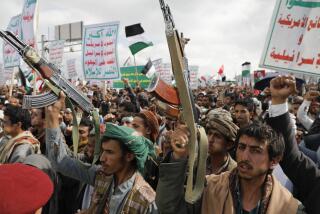New Strategy May Bring End to Scud Threat
RIYADH, Saudi Arabia — For weeks now, the most palpable fear on this side of the fighting has been of the Scud missile, that inaccurate but nevertheless deadly piece of supersonic machinery that has been aimed at Saudi Arabia and Israel since the fighting began.
The Scud comes only at night, when allied planes have more difficulty in targeting the missile and its launcher, and the announcement of the Scud approach has taken on a kind of routine--first the air raid sirens, then the sound of Patriot air-defense missiles leaving the ground in a whoosh, followed, almost always, by a flash and a large bang when the Scud is hit.
Now, the military has developed a new anti-Scud strategy, one in which warplanes attack the missile launchers within seconds of firing--in some cases, even before the missile is fired. As a result, officers say, they are very close to eliminating the Scud as a threat to both countries. “We might be only five heartbeats away if we do it right,” one military source said.
The Scuds threatening Israel and Saudi Arabia are Soviet-designed missiles that have been jury-rigged by Iraq to give them the extra boost needed to travel this far. As such, they are sometimes viewed as the equivalent of an old car held together by bad welds, baling wire and electrical tape. But the fear they cause is inescapable.
“As far as accuracy is concerned, it certainly is militarily insignificant,” said Gen. H. Norman Schwarzkopf, the commander of the allied forces, in a recent briefing. “But it is a terror weapon. It’s a terror weapon that’s been used against civilian population centers, and that makes it important.”
As part of the new tactic, allied warplanes cruise Iraqi airspace, their instruments scanning for heat generated by a rocket engine; when it is detected, the pilot dives and strikes. Quick reaction time is obviously vital to this tactic.
“They sense we are close, that we’re around, that we are able to hit them fast and hard,” said one military source.
The most recent results of those new methods came early Sunday morning, when three Iraqi missiles were fired at targets in both Israel and Saudi Arabia. In a military communique issued later in the day, the U.S. Central Command said that while the firing of missiles was not preempted, counter-Scud patrols were “still able to attack two of the three launch sites. Pilots reported secondary explosions at one of the sites.”
Two of the missiles landed in the central area of Israel, with no reports of injuries. The third, aimed at Riyadh, was intercepted by two Patriot missiles.
At a Sunday briefing, military experts laid out in the greatest detail so far the cat-and-mouse game that is going on between the allies and the Iraqis in the effort to destroy the mobile sites. It is a game the allies, who dominate the skies over Iraq, now feel that they are winning.
Military officials believe that the new system is one of the key reasons why Scud launches have dramatically decreased in the last week. The total firings have dropped from 35 in the first week of the war to 18 in the second to a total of four so far this week. Now, military officials say, instead of firing with impunity before moving to another location, the missile launcher crews face the prospect of becoming a target even before the missile is fired.
One graphic example of the new strike capability was demonstrated in a film shown at a Schwarzkopf briefing last Wednesday in which at least three mobile launchers were destroyed and a total of 11 vehicles were destroyed on one bombing run over Iraq.
“I certainly can’t say there will be no more Scud launches,” said Schwarzkopf. “I can never say that. But I have a high degree of confidence we’re getting better and better at our ability to find them.”
Another military expert brought it down to what might now be happening on the ground: “You can bet there are some trembling hands when they are setting the coordinates (of the missile targets),” he said.
That official also outlined how the mobile missiles had, over time, become easier to track as the Scud-hunters had plotted the coordinates of missiles fired during the last three weeks. He said the soldiers firing the launchers are often creatures of habit, driving to their favorite hilltop and firing because the coordinates for targets in Israel and Saudi Arabia are already set for that location.
“The mobiles like to fire from some places rather than others,” he said.
According to the official, once a missile in flight is detected by radar, the location is immediately relayed to warplanes flying in the area.
“The battlefield is changing,” he said. “Once there’s enough launches, you can plot and predict. That’s where we’re making our money now.”
More to Read
Sign up for Essential California
The most important California stories and recommendations in your inbox every morning.
You may occasionally receive promotional content from the Los Angeles Times.










